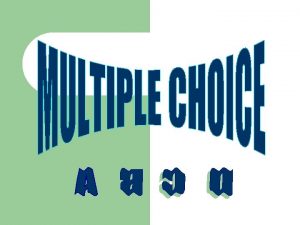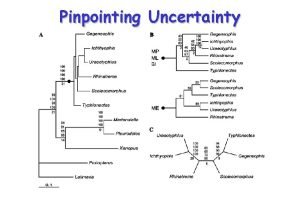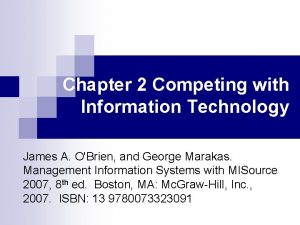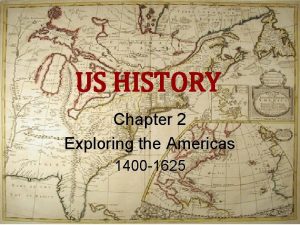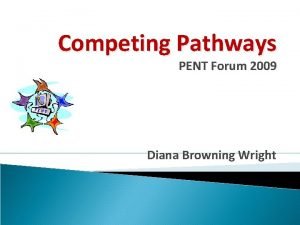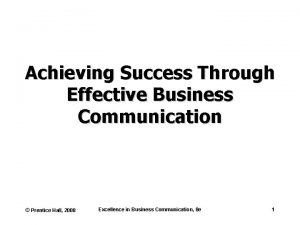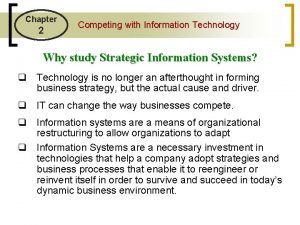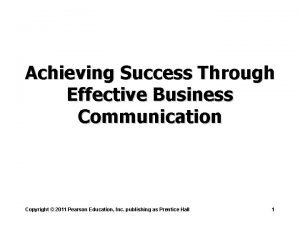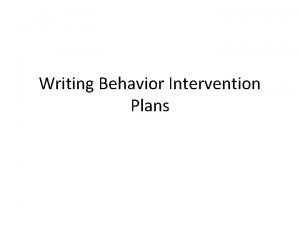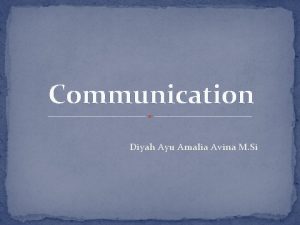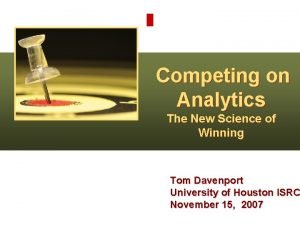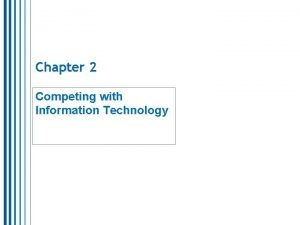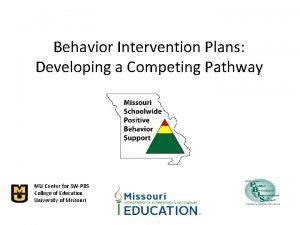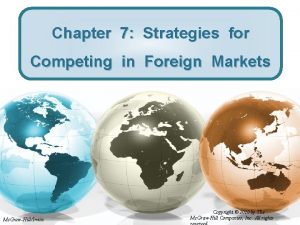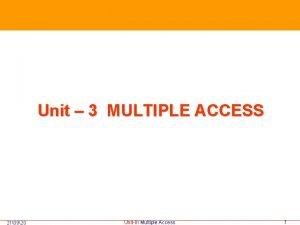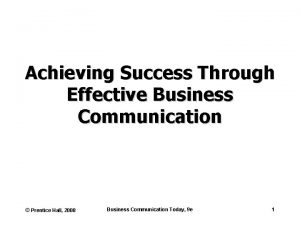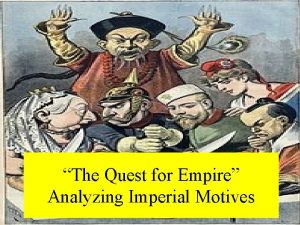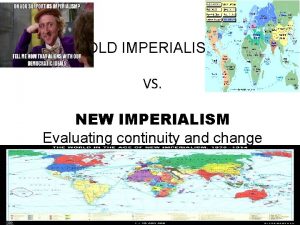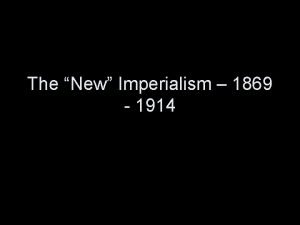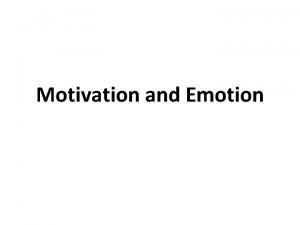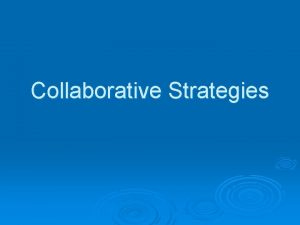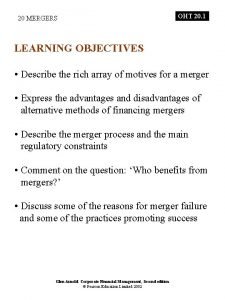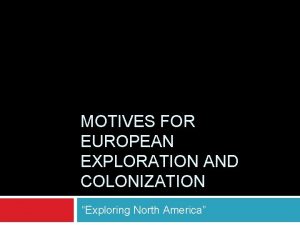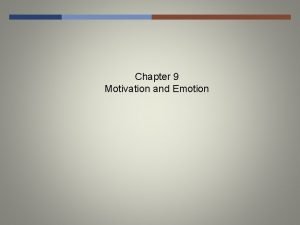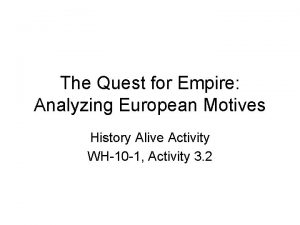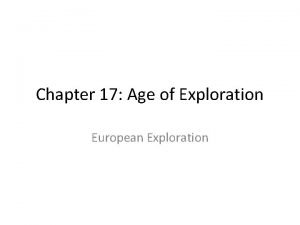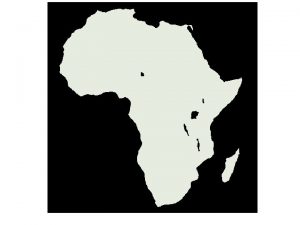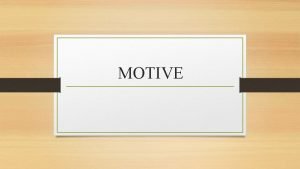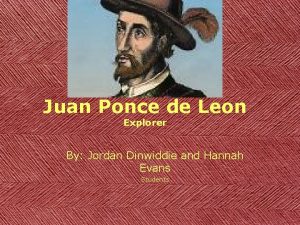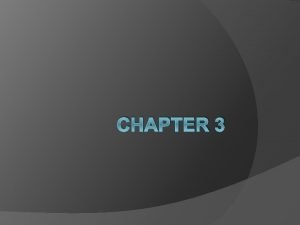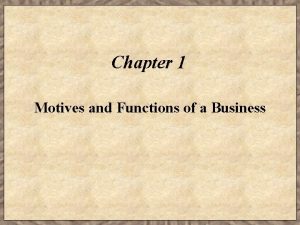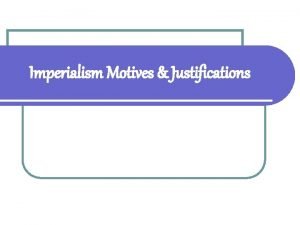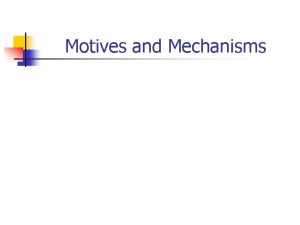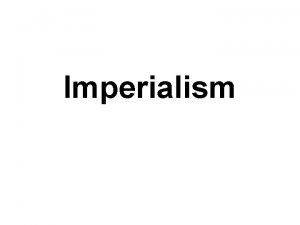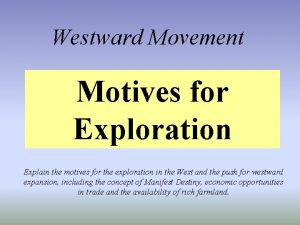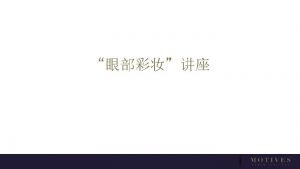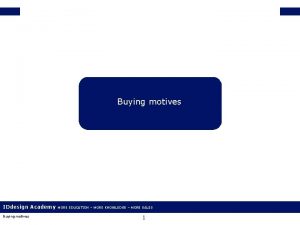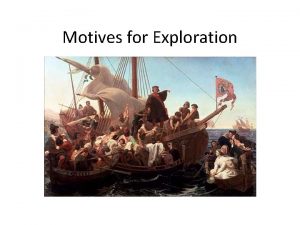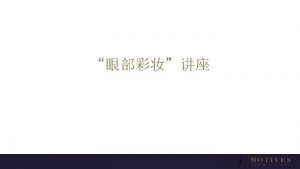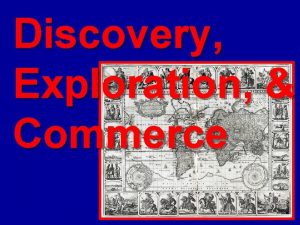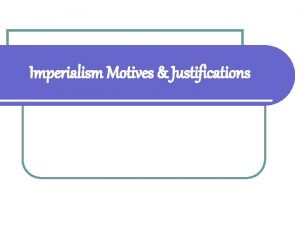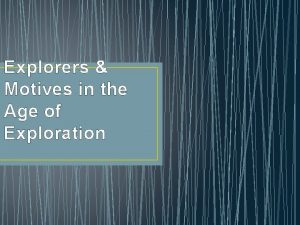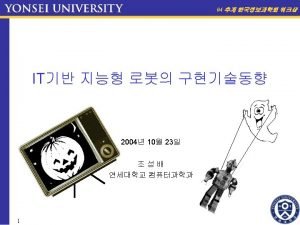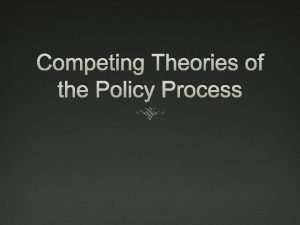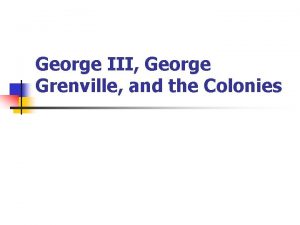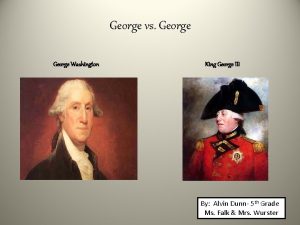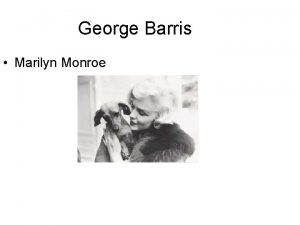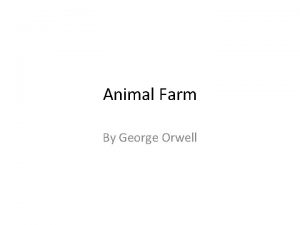Let Me or Let George Motives of Competing

















































- Slides: 49

Let Me, or Let George? Motives of Competing Altruists Ted Bergstrom, Rod Garratt, Greg Leo (UCSB) (Vanderbilt)

A curious tension Technology seems to offer significant economies of scale to group size—a costly action taken by a single member is often sufficient to benefit the entire group, no matter how large the group. But with increasing group size, the “free rider problem” may become more acute, with each group member deciding to “Let George do it. ”

Mancur Olson The Logic of Collective Action (1965) “The larger a group is, the further it will fall short of obtaining an optimal supply of any collective good, and the less likely that it will act to obtain even a minimal amount of such a good. ”

Who, me?

All right, whose gonna jump in first?

Meerkat on watch duty

Volunteer’s Dilemma Game Andreas Diekmann (1985) Assumptions: • If at least one player volunteers: Those who volunteer get V-c>0 Those who don’t volunteer get V • If nobody volunteers, all players get 0 Conclusion: In symmetric equilibrium, the probability that nobody volunteers increases with group size.

Coordinated Volunteer's Dilemma One Volunteer Picked at Random Weesie, Franzen (1998) Bergstrom, Leo (2015) Higher probability of some volunteer than uncoordinated case, . . . But in symmetric Nash equilibrium, probability of no volunteer still increases with group size.

Some success stories: Public goods provided voluntarily despite free rider problem

Wikipedia contains over 5 million articles, written by thousands of unpaid anonymous writers

Each year, in the USA, about 9. 2 million people donate blood

More than 12, 000 computer programmers have contributed unpaid volunteer coding to the Linux operating system

20 million people worldwide have offered to donate stem cells or bone marrow to save the life of a complete stranger

Bone marrow registry: Because the registry is large enough to serve most of those with rare types, it must include a large number of suitable matches for people of relatively common immunity types. 90% chance that, if you are asked, there is another equally good match in the registry (Bergstrom et al, 2009)

Other factors at play. . . “Warm glow” Andreoni (1990)

“You could be so lucky as to be the one whose donation saves a life. ”

Goal of this study Conduct experiments designed to identify donor motives; see if sufficient to explain successes We do not induce altruistic payoffs like in past VOD experiments that have an "if one gives up some money everyone gets more money structure. " Rather we give subjects the opportunity to commit an altruistic act and leave it to them how to value this. Our subjects have no chance of an increased monetary payoff if they donate; only increase in payoff must come from pleasure of giving to help someone less fortunate than themselves.

Experimental design

Subjects are seated at terminals in the lab. They are told that they are one of a group of n+1 people (in separate rounds, n varies from 1 to 7) In any round, all but one of the group members are told that they have received a $10 bonus, while one member of their group was “unlucky” and did not receive the $10.

Subjects are told that if any group member volunteers to give up a small amount $c, the unlucky member will receive $10 -c. Only one volunteer is needed to do the job. We will take the first individual to volunteer, or if there are ties, we will randomly select one of those who are first.

There will be a 30 -second time window in which subjects can volunteer. One can also press a button for one of the following: first-possible-moment last-possible-moment not at all



There are 13 rounds of play. Subjects are reshuffled into randomly selected groups of varying size after each round. A subject is a potential volunteer in 9 or 10 rounds. The “unlucky” group member in any round does not take any action Outcomes are reported only at the end of the experiment. Subjects will be paid their earnings from one randomly selected round.

If there is at least one volunteer, then the group member who did not receive an initial bonus receives $10 -c. If a single player volunteers before anyone else, then that volunteer pays $c. If there is a tie for first volunteer, then one of these first volunteers is selected at random to pay $c. At the end of the experiment, subjects are paid their earnings from one randomly selected round.

2 x 2 design in which we vary the cost of helping and the anonymity of donors. Cost of helping: c = 1 and c = 4 Anonymity: Anonymous treatment: no player’s actions are revealed to others Public treatment: Identity of those chosen to be donors is revealed to all subjects in the experiment.

Results


Possible payoffs bi : value to i of having task done ci : cost to i of doing the task gi : value of “warm glow” from doing it oneself vi: value of being a volunteer

Possible outcomes and their payoffs Outcome A) Player i volunteers and does the task. bi+gi+vi-ci Outcome B) Player i volunteers, but someone else is selected. bi+vi Outcome C) Player I does not volunteer, but someone else does. bi Outcome D) Nobody volunteers. 0 Since we assume that bi≥ 0, gi≥ 0, and vi≥ 0, it must be that i prefers Outcome B to C and C to D. We classify people by where they rank A relative to the other 3.

Let-me-do-it types Outcome A) Player i volunteers and does the task. bi+gi+vi-ci Outcome B) Player i volunteers, but someone else is selected. bi+gi Outcome C) Player I does not volunteer, but someone else does. bi Outcome D) Nobody volunteers. 0 Let-me-do-it types rank Outcome A first. They would rather do it themselves than have somebody else do it.

No-not-me types Outcome B) Player i volunteers, but someone else is selected. bi+gi Outcome C) Player I does not volunteer, but someone else does. bi Outcome D) Nobody volunteers. 0 Outcome A) Player i volunteers and does the task. bi+gi+vi-ci No-not-me types rank Outcome A last. They would not want to do it even if nobody does it.

Last-resort consequentialists Outcome B) Player i volunteers, but someone else is selected. bi+gi Outcome A) Player i volunteers and does the task. bi+gi+vi-ci Outcome C) Player i does not volunteer, but someone else does. bi (Or) Outcome A) Player i volunteers and does the task. bi+gi+vi-ci Outcome D) Nobody volunteers. 0 Last resort consequentialists rank Outcome A either second or third. Their first choice is for someone else to do it. They would rather do it themselves than have nobody else do it.

g=warm glow, v=pleasure from volunteering, c=cost b=benefit to seeing task done g>c b+v+g<c b+v+g>c g<c

With 2 or more contributors First moment = let-me-do-it type Last moment or not at all = no-not-me type or lastresort consequentialist Middle = other type Single donor case Not volunteer = no-not-me type Determine frequency of last-resort types by subtracting nonot-me types

22% 36% Let-me-do-it 38% 15% 19% 33% 29% Last-resort 21% 42% 40% No-Not-me 17% 19% 18% 12% 16% Public Anon Public Other Anon $1/$9 $4/$6

Results are consistent with comparative static predictions When c was increased from 1 to 4, fraction of let-me-do-it types decreased and the fraction who acted as no-not-me types increased (with or without recognition). Prediction on last-resort is ambiguous, but fraction decreases

With recognition: the fraction of let-me-do-it types is larger for both cost treatments; the proportion who acted as nonot-me types was slightly smaller for the low cost treatment and slightly larger in high cost treatment In total, 7 of the 8 predictions made by our model hold in the experimental data.

Group size has no (significant effect) on the number of let -me-do-it types. No theoretical predictions on how probability that an individual will not volunteer varies with group size, but we observe: 1. when volunteering is cheap, the fraction who do not volunteer increases from 20% to 30% 2. when volunteering is more costly, the fraction who do not volunteer increases from 40% to 60%

Donor Activity and Gender Half of our subjects had donated blood and 13 percent were registered as potential bone marrow donors; Slightly more than half of our subjects are female. Blood donors are more likely to volunteer at the last moment. Bone marrow registrants are more likely to volunteer at the first moment Women are more likely than men to volunteer when donating is cheap, but not when donating is expensive

Post-game interview

Other experimental work Darley and Latane (1968): fraction of observers who reported emergency diminished sharply as number of observers increased, while probability at least one observer took action remained constant Goeree, Holt and Moore (2005): large groups volunteer more than Nash prediction Vesterlund et al. (2015)) compares the behavior of men to women in VOD game; also have a clock; find women are more likely than men to volunteer first to benefit group

Discussion The presence of a small minority of let-me-do-it types among a large number of potential helpers is sufficient to guarantee that the task will be performed with high probability. We find significant numbers of let-me-do-it types Bodes well for. . . Bone Marrow Registry where Bergstrom et al show optimal registry requires participation of only 5 percent of population Wikipedia where the number of active contributors is less than 1/10 of 1 percent of the number of users. Might not be enough for. . . Kidneys, blood and plasma donation (payments may be needed)

Addendum: A Discourse on Experimental Methodology A common type of economics experiment. Take a game that has theoretical interest. Assign money payoffs that mirror payoffs in theoretical model. See if people reach Nash equilibrium, perhaps after repeated play with shifting partners. They don’t. Now what do you do? Claim they did. Dream up some cock-eyed preferences that rationalize your data. (It helps to have plenty of parameters) Simplify game or improve learning environment and try again. Look for plausible heuristics that people may be (mistakenly) lifting over from everyday experience

Game theory experiments have two problems that are often confounded. A) Players are not motivated simply by money payoffs. Examples: Player 2 in ultimatum game. Dictator in dictator game. B) Many subjects don’t have experience, time, motivation, or intellectual tools to solve for best responses for your game.

An example. Standard experimental economists’ treatment of Volunteers’ dilemma attempts to understand altruistic motivation by running experiments in which they try to induce “altruistic” action with money payoffs. If anyone in the group pays $c, then all in group get $V-c. (e. g. Goeree, Holt, & Moore, or Vesterlund and Niederle) Your motive to donate is that others may not and then it is in your selfish interest to donate. But does motivation simply follow money payoff in charitable contexts? .

In our experiment, you get no money reward from donating. For selfish players, the obvious equilibrium action is “no-not-me”/ We don’t tell you what donating is worth to you and then hope you believe us. We try to learn about the distribution of motives to donate from observing behavior in a situation with explicit charitable context. There is a bit of game theoretic interaction, but it is very simple and the effects we test for require little abstract reasoning. We try to place subjects in a simple and familiar situation. We hope that we observe are patterns of behavior that people carry over from the ordinary business of life.

Thank you!* * T h

Let me do it!
 Let me let me let me
Let me let me let me Differences between george washington and king george iii
Differences between george washington and king george iii Venn diagram george washington and king george iii
Venn diagram george washington and king george iii Why does carlson insist on shooting candy’s dog
Why does carlson insist on shooting candy’s dog Analysis of competing hypotheses template
Analysis of competing hypotheses template Competing with information technology
Competing with information technology Competing messages communication barriers
Competing messages communication barriers Lesson 4 competing for colonies
Lesson 4 competing for colonies Competing for advantage
Competing for advantage Competing pathways chart
Competing pathways chart Achieving success through effective business communication
Achieving success through effective business communication Competing with information technology
Competing with information technology Competing messages communication barriers
Competing messages communication barriers Competing behavior pathway example
Competing behavior pathway example Cultural noise example
Cultural noise example Five actors were competing for the leading role in the play
Five actors were competing for the leading role in the play Competing on analytics
Competing on analytics The competing visions of reconstruction
The competing visions of reconstruction Competing with information technology
Competing with information technology Competing behavior pathway example
Competing behavior pathway example Ten thousand airline reservation stations are competing for
Ten thousand airline reservation stations are competing for Competing for colonies
Competing for colonies Behavior pathway
Behavior pathway Strategies for competing in international markets
Strategies for competing in international markets A network using csma/cd has a bandwidth of 10mbps
A network using csma/cd has a bandwidth of 10mbps Competing with information technology
Competing with information technology Turtle conflict style
Turtle conflict style Competing messages communication barriers
Competing messages communication barriers The patterns of feelings motives and behavior
The patterns of feelings motives and behavior Leading motives quest
Leading motives quest Old vs new imperialism
Old vs new imperialism Motives of imperialism
Motives of imperialism Interior motives flemington nj
Interior motives flemington nj Primary and secondary emotions chart
Primary and secondary emotions chart Types of collaborative arrangements
Types of collaborative arrangements Motives of merger
Motives of merger Vasco nunez de balboa motives for exploration
Vasco nunez de balboa motives for exploration Roanoke island mystery
Roanoke island mystery Bringing ivory to the wagons in south africa
Bringing ivory to the wagons in south africa Ponce de leon motives for exploration
Ponce de leon motives for exploration Hypothetical dailymotion
Hypothetical dailymotion Consumer behaviour meaning
Consumer behaviour meaning Ivory
Ivory Triangular trade
Triangular trade Old imperialism vs new imperialism
Old imperialism vs new imperialism Motives concealer
Motives concealer Motivation cycle in psychology
Motivation cycle in psychology Juan ponce de leon route map
Juan ponce de leon route map Motives for colonizing plymouth
Motives for colonizing plymouth Business motives
Business motives



